- Home
- About
- Map
- Trips
- Bringing Boat West
- Migration West
- Solo Motorcycle Ride
- Final Family XC Trip
- Colorado Rockies
- Graduates' XC Trip
- Yosemite & Nevada
- Colorado & Utah
- Best of Utah
- Southern Loop
- Pacific Northwest
- Northern Loop
- Los Angeles to NYC
- East Coast Trips
- Martha's Vineyard
- 1 Week in Quebec
- Southeast Coast
- NH Backpacking
- Martha's Vineyard
- Canadian Maritimes
- Ocracoke Island
- Edisto Island
- First Landing '02
- Hunting Island '02
- Stowe in Winter
- Hunting Island '01
- Lake Placid
- Chesapeake
- Provincetown
- Hunting Island '00
- Acadia in Winter
- Boston Suburbs
- Niagara Falls
- First Landing '99
- Cape Hatteras
- West Coast Trips
- Burning Man
- Utah Off-Roading
- Maui
- Mojave 4WD Course
- Colorado River Rafting
- Bishop & Death Valley
- Kauai
- Yosemite Fall
- Utah Off-Road
- Lost Coast
- Yosemite Valley
- Arizona and New Mexico
- Pescadero & Capitola
- Bishop & Death Valley
- San Diego, Anza Borrego, Joshua Tree
- Carmel
- Death Valley in Fall
- Yosemite in the Fall
- Pacific Northwest
- Utah Off-Roading
- Southern CA Deserts
- Yosemite & Covid
- Lake Powell Covid
- Eastern Sierra & Covid
- Bishop & Death Valley
- Central & SE Oregon
- Mojave Road
- Eastern Sierra
- Trinity Alps
- Tuolumne Meadows
- Lake Powell Boating
- Eastern Sierra
- Yosemite Winter
- Hawaii
- 4WD Eastern Sierra
- 4WD Death Valley +
- Southern CA Deserts
- Christmas in Tahoe
- Yosemite & Pinnacles
- Totality
- Yosemite & Sierra
- Yosemite Christmas
- Yosemite, San Diego
- Yosemite & North CA
- Seattle to Sierra
- Southwest Deserts
- Yosemite & Sierra
- Pacific Northwest
- Yosemite & South CA
- Pacific Northwest
- Northern California
- Southern Alaska
- Vancouver Island
- International Trips
- Index
- Tips
- Books
- Photos/Videos
- Search
- Contact
Galapagos - Isabela and Fernandina Islands, Ecuador
Monday, March 20, 2023 - 8:30pm by Lolo
miles and 1 hour from our last stop - 1 night stay
Travelogue
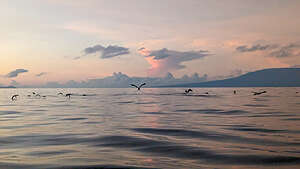 Pre-dawn panga cruise with the seabirdsAt 80 miles long, Isabella is the largest island in the Galapagos by far, covering more than half the landmass of the entire archipelago. It is also one of the youngest islands, dominated by six intermittently active, shield volcanoes.
Pre-dawn panga cruise with the seabirdsAt 80 miles long, Isabella is the largest island in the Galapagos by far, covering more than half the landmass of the entire archipelago. It is also one of the youngest islands, dominated by six intermittently active, shield volcanoes.
In fact, it was originally six separate islands, each with its own active volcano. Eventually the lava flows from the six (Cerro Azul, Sierra Negra, Alcedo, Darwin, Wolf, and Ecuador) joined together forming one large island, shaped like a seahorse.
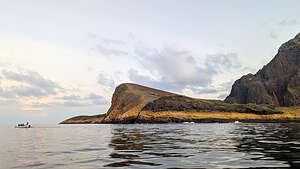 Rounding Punta Vicente RocaWe started our day exploring Punta Vicente Roca, at the tip of the seahorse's nose. It’s a marine-only visitor site (no landings permitted), so we enjoyed the sights and the wildlife from the comfort of our panga - just us and the seabirds getting an early start on their day.
Rounding Punta Vicente RocaWe started our day exploring Punta Vicente Roca, at the tip of the seahorse's nose. It’s a marine-only visitor site (no landings permitted), so we enjoyed the sights and the wildlife from the comfort of our panga - just us and the seabirds getting an early start on their day.
The scenery around the Point was stunning - spectacular cliffs formed out of tuff (volcanic ash) from the remains of two ancient volcanoes. A brown pelican stood at the edge of the cliff indifferently watching us pass by.
In the distance we could see the entrance to a sea cave, eroded from the tuff wall by the constant pounding of the sea, which we would explore later in the morning.
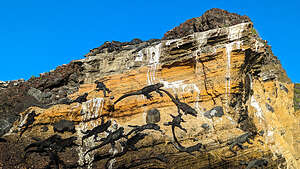 Marine Iguanas warming up on the cliffsWe cruised along the cliff walls, mesmerized by the early morning activity of a very interesting and diverse group of wildlife, all getting ready to start their day.
Marine Iguanas warming up on the cliffsWe cruised along the cliff walls, mesmerized by the early morning activity of a very interesting and diverse group of wildlife, all getting ready to start their day.
Marine iguanas clung to the vertical walls as if they had suction cups on their feet, some of them seeming to be holding hands (or more correctly, claws) in a type of circular dance, except none of them moved. They just stayed still, warming their cold-blooded bodies by absorbing the rays of the sun. It reminded me of Henri Matisse’s painting “The Dance.”
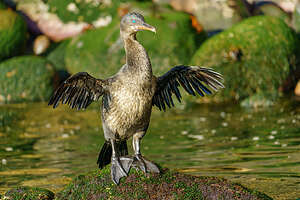 Flightless cormorant drying his wingsWe met a flightless cormorant for the first time, with bright, blue eyes and stunted wings. As their name implies, these birds are truly unable to fly. They are a great example of evolution and how a species adapts to its environment. Having few predators or competitors for food close to shore, they really didn’t need wings that much, so their wings gradually atrophied and their bodies evolved to be more streamlined for swimming. They are excellent divers that can speed through the water after fish. Trust me, I have been snorkeling when several of them whizzed by.
Flightless cormorant drying his wingsWe met a flightless cormorant for the first time, with bright, blue eyes and stunted wings. As their name implies, these birds are truly unable to fly. They are a great example of evolution and how a species adapts to its environment. Having few predators or competitors for food close to shore, they really didn’t need wings that much, so their wings gradually atrophied and their bodies evolved to be more streamlined for swimming. They are excellent divers that can speed through the water after fish. Trust me, I have been snorkeling when several of them whizzed by.
Since their wings don’t produce very much oil, they have lost some of their waterproofing, so after a dive, they hold them out to dry.
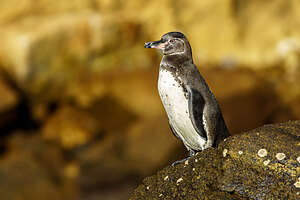 Our first penguin!We watched a flightless cormorant pluck a large piece of seaweed from the surf, and valiantly proceed to hop his way up a rocky cliff to complete his morning chore of building a nest. Since they can’t fly, they hop up to the nest, using their stunted wings for balance.
Our first penguin!We watched a flightless cormorant pluck a large piece of seaweed from the surf, and valiantly proceed to hop his way up a rocky cliff to complete his morning chore of building a nest. Since they can’t fly, they hop up to the nest, using their stunted wings for balance.
Then there was a Galapagos penguin doing what he does best, peering out at the sea looking cute.
You might wonder what a penguin is doing at the equator. So did the first ones that arrived here when they rode the Humboldt Current from the Chilean Patagonia. After the glaciers melted, they were stranded here. They seem to do just fine though. They are really, really fast underwater. Between them and the cormorants whizzing by, snorkeling here can be quite exciting.
 Entrance to the sea caveTheir challenge is keeping cool, which they do by spending a lot of time in and near the water. When they are on land you sometimes see them holding their flippers out cooling their armpits (or maybe more correctly, flipper pits).
Entrance to the sea caveTheir challenge is keeping cool, which they do by spending a lot of time in and near the water. When they are on land you sometimes see them holding their flippers out cooling their armpits (or maybe more correctly, flipper pits).
Then, of course, there were our old friends, the blue-footed boobies and Sally Lightfoot crabs, which never fail to delight.
The Sally Lightfoots scampered across the steep cliff walls as if they were on level ground. Being a family of rock climbers, we were amused to see one of them headed right towards a large vertical crack in the wall, as if he was going to climb it.
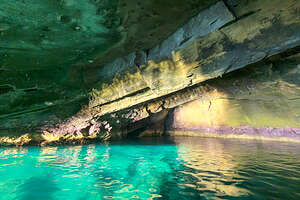 Inside the sea caveEventually, we made our way to the entrance of the sea cave, which looked barely high enough to fit us. The cave was surreal, with purple and yellow walls flickering like flames in the early morning light.
Inside the sea caveEventually, we made our way to the entrance of the sea cave, which looked barely high enough to fit us. The cave was surreal, with purple and yellow walls flickering like flames in the early morning light.
Meanwhile, below us, a large school of fish swam in the beautiful aquamarine green water, which seemed as if it was lit from below.
What a fabulous morning, but it wasn’t over yet, as we still had our daily snorkeling event, and today was supposed to be a really good one, because the upwelling of cold water currents in this part of the Galapagos gives rise to an abundance of marine life.
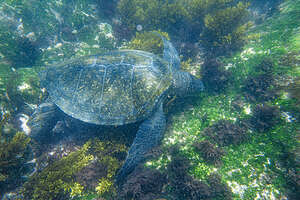 Snorkeling with a Giant Sea TurtleDue to the jellyfish stinging incident the other day (not me, but most of the rest of the group), I had devised a new snorkeling outfit to leave no exposed skin - Lululemon tights under my short wetsuit, a long-sleeve rashguard, and a tiny cap to keep my hair out of my eyes.
Snorkeling with a Giant Sea TurtleDue to the jellyfish stinging incident the other day (not me, but most of the rest of the group), I had devised a new snorkeling outfit to leave no exposed skin - Lululemon tights under my short wetsuit, a long-sleeve rashguard, and a tiny cap to keep my hair out of my eyes.
Today was definitely a very exciting snorkeling day. We saw giant sea tortoises feeding on the algae at the bottom. When rising to the surface, they often came right at me, causing me to flee or spread my legs apart so they could scoot through.
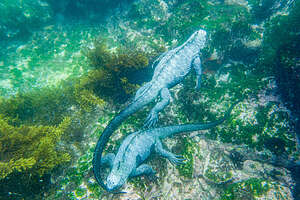 Snorkeling with marine iguanasThere were dozens of marine iguanas who enter the water during the hottest part of the day to feed on the red and green algae on the rocks. They just scooted around, paying no attention to us, and occasionally even bumping into us. I think I was very brave.
Snorkeling with marine iguanasThere were dozens of marine iguanas who enter the water during the hottest part of the day to feed on the red and green algae on the rocks. They just scooted around, paying no attention to us, and occasionally even bumping into us. I think I was very brave.
Penguins are extremely fast in the water, darting by so quickly that it was hard for Herb to capture a photo of anything other than their butts. He did manage to get one though.
Herb was in the water when he popped his head up and saw these two marine iguanas cuddling on the shore.
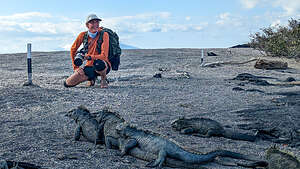 Marine Iguana pile-upIt was so exhilarating and the hour flew by, almost as quick as the penguins.
Marine Iguana pile-upIt was so exhilarating and the hour flew by, almost as quick as the penguins.
After lunch and a siesta, we went back out on the pangas for a dry landing on nearby Fernandina Island, the youngest and most volcanically active island in the archipelago. Its volcano, La Cumbre, has erupted several times in recent years, the most recent being in 2017.
There is only one visitor site on Fernandina, Punta Espinosa, so that is where we headed for a dry landing on a dock, which is only good at high tide - spoiler alert, it was low tide when we were finished exploring the island.
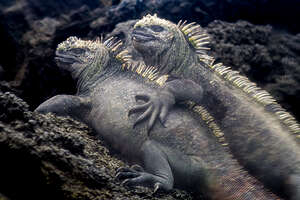 Best buddiesFernandina has the largest colony of marine iguanas in the entire Galapagos, so we weren’t too surprised when we were barely off the dock before we stumbled (almost literally, as they are so well disguised against the black rock) upon a group of them.
Best buddiesFernandina has the largest colony of marine iguanas in the entire Galapagos, so we weren’t too surprised when we were barely off the dock before we stumbled (almost literally, as they are so well disguised against the black rock) upon a group of them.
Then about 100 yards further, we came upon a group of larger ones doing acrobatics, climbing all over each other, often in groups of three. They do this to keep warm. I wasn’t sure how they decided who gets to be on the top, middle, and bottom. I’m not even sure what’s best.
We came across our first lava lizard sitting contentedly on a marine iguana back. I bet he felt safe up there from predators.
 Scary marine iguanaAt 6 to 8 inches long, lava lizards are not as impressive as their larger relatives, the iguanas, but they are cute and interesting in their own way. They have to be much more alert and quick than the iguanas to avoid being gobbled up by birds or snakes. However, they developed some very effective traits to avoid being eaten, such as changing color to camouflage themselves and leaving a breakaway tail behind in the predator’s mouth, when they haven’t been quick enough. Don’t worry, they do grow a new one back.
Scary marine iguanaAt 6 to 8 inches long, lava lizards are not as impressive as their larger relatives, the iguanas, but they are cute and interesting in their own way. They have to be much more alert and quick than the iguanas to avoid being gobbled up by birds or snakes. However, they developed some very effective traits to avoid being eaten, such as changing color to camouflage themselves and leaving a breakaway tail behind in the predator’s mouth, when they haven’t been quick enough. Don’t worry, they do grow a new one back.
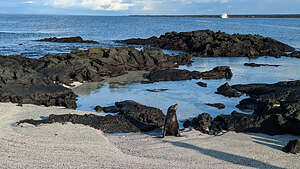 Bull sea lion guarding his territoryThe males are often seen doing what looks like push-ups, which is a show of strength to impress the ladies. The males in the Galapagos seem to always have the ladies in mind, or at least this time of year.
Bull sea lion guarding his territoryThe males are often seen doing what looks like push-ups, which is a show of strength to impress the ladies. The males in the Galapagos seem to always have the ladies in mind, or at least this time of year.
After wading through the sea of marine iguanas, we eventually got to the tip of the point, where there were dozens of Sally Lightfoot crabs covering the rocky volcanic coastline.
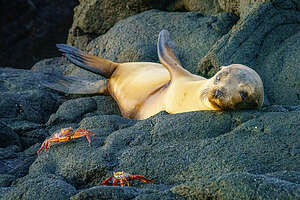 Adorable sea lion pupThere was also a large colony of sea lions, and much loud barking and splashing about in the water.
Adorable sea lion pupThere was also a large colony of sea lions, and much loud barking and splashing about in the water.
We had already spent time with the cute variety of playful young sea lions, but today we would meet the more aggressive adult bulls, which can grow up to 600 pounds. The males are distinguished by a larger girth, thicker neck, and a noticeable bump on their forehead. They use their large size to defend their territories, which included about 70 feet of shoreline and the shallow waters beyond.
All the females within this territory (up to 30) belong to the bull's harem as mating partners, as well as any juveniles within the harem. The bull is constantly at work defending his territory, swimming back and forth from one end to the other.
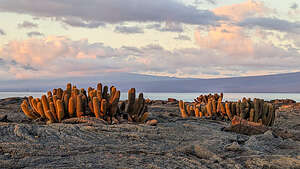 Lava cactusSince the bulls way outnumber the harems, there is constant conflict between the resident bull and the harem-less ones challenging him. Sometimes it is just a bit of show of aggression, but other times it can result in a fierce, bloody battle.
Lava cactusSince the bulls way outnumber the harems, there is constant conflict between the resident bull and the harem-less ones challenging him. Sometimes it is just a bit of show of aggression, but other times it can result in a fierce, bloody battle.
This goes on for weeks, with the resident bull going without food and sleep for long periods of time in his efforts to defend his territory, until he is eventually vanquished by a new champion, and the cycle repeats itself.
This behavior actually makes sense from an evolutionary standpoint. The resident bull's behavior is likely an evolved mechanism to best defend and ensure the survival of the colony, as someone, either he or the new champion, is always on guard.
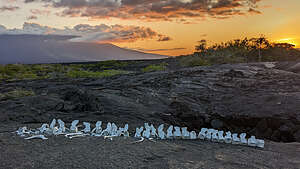 Whale BonesThey don't necessarily give photographers a free pass, and there were several times where one of us got a little too close, forcing a rapid retreat as the bull barked and moved a bit too quickly towards us.
Whale BonesThey don't necessarily give photographers a free pass, and there were several times where one of us got a little too close, forcing a rapid retreat as the bull barked and moved a bit too quickly towards us.
On our walk back, we continued on a second trail which wound its way through a lava field. While the lava flow has obliterated much of the vegetation, several pioneering plants, including clumps of lava cactus, have begun to take hold.
A little further along, we came across a skeleton of a whale’s backbone, looking like a lineup of tombstones in the evening light.
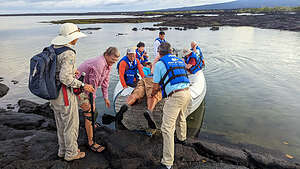 Less than elegant entry onto pangaAs we passed a group of marine iguanas, we caught one doing its characteristic spit. While it might look like it is an insult directed towards you, it is actually him expelling the excess salt from its system through a special gland connected to the nostrils. It’s also what sometimes gives them a white-crusted forehead.
Less than elegant entry onto pangaAs we passed a group of marine iguanas, we caught one doing its characteristic spit. While it might look like it is an insult directed towards you, it is actually him expelling the excess salt from its system through a special gland connected to the nostrils. It’s also what sometimes gives them a white-crusted forehead.
It was way past high tide when we returned to the panga pickup area, so the dock was no longer an option.
 Homeward boundInstead the panga drivers had to back the boat up against slippery rocks, where aging photographers thrust themselves like beached whales onto the boat. At one point, Tui even jumped overboard in her clothes to try to hold the boat close enough to the rocks for us to get in. She is really a superwoman!
Homeward boundInstead the panga drivers had to back the boat up against slippery rocks, where aging photographers thrust themselves like beached whales onto the boat. At one point, Tui even jumped overboard in her clothes to try to hold the boat close enough to the rocks for us to get in. She is really a superwoman!
It was worth every undignified moment.
Recap of creatures we saw today: brown pelicans, blue-footed boobies, marine iguanas, lava lizards, Sally Lightfoot crabs, flightless cormorants, penguins, sea tortoises (underwater), sea lions
- ‹ previous
- 6 of 13
- next ›
Galapagos - Isabela and Fernandina Islands location map in "high definition"
Javascript is required to view this map.
